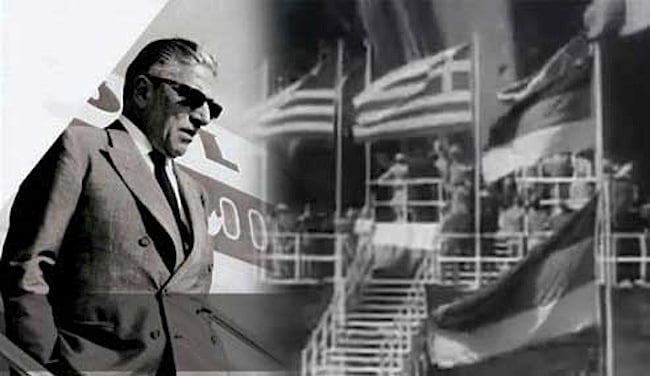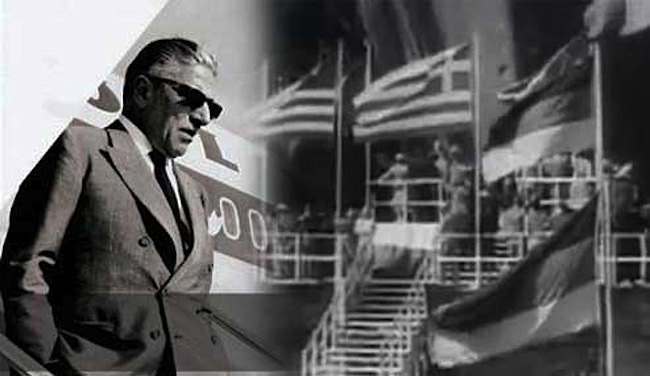

Aristotle Onassis, the famous Greek shipping tycoon, played a significant role in helping post-WWII Germany’s economy through his shipbuilding activities.
After WWII, Germany’s shipbuilding industry—especially in places like Hamburg and Kiel—was heavily damaged but began rebuilding quickly with the help of the Marshall Plan and foreign investment. Onassis, who was already an established figure in global shipping by the late 1940s and early 1950s, saw an opportunity.
In the 1950s and 1960s, Onassis ordered a number of large tankers and cargo ships from German shipyards. His contracts were highly lucrative and offered a much-needed boost to German shipbuilders, injecting capital and restoring global confidence in German industrial capacity.
He was known for negotiating hard, often using competitive bids between German, Japanese, and Scandinavian yards, but he remained loyal to some key German shipyards that met his standards.
The Hamburg-based Howaldtswerke would play a key role. In 1952, he founded his shipping company Olympic Maritime, of which he automatically established a German branch based in Hamburg. Through this company, Onassis would invest 300 million Deutsche Marks (worth approximately $818 million today, adjusted for inflation) in the following years in the construction of oil tankers in Germany.
This shipbuilding business provided jobs and income during Germany’s Wirtschaftswunder (economic miracle). Onassis’s tankers were cutting-edge for the time, and his orders pushed German engineering to innovate, especially in super-tanker construction. It also helped rebuild Germany’s reputation as a reliable industrial and shipbuilding power.

Onassis built about 20 tankers in Germany’s shipyards. The most illustrious of all was the tanker Tina Onassis in 1953, which was a revolution in terms of the size of a tanker should be.
The tanker was named after Onassis’ wife Tina Livanos, an English-born Greek-French socialite and shipping heiress.
At the beginning of 1952, the Howaldtswerke in Kiel received an order to build 8 tankers with a capacity of 32500 DWT for the company World Tanker Inc. At the time, it was assumed that this was the maximum size of a tanker and they were called “supertankers”. But the Onassis company wanted more than this size. On October 15, 1952, the public was surprised by the following press release:
Gigantic tanker launched!
Yesterday, the first tanker with a capacity of 45000 tons, hull number 885, was laid down at the Hamburg Howaldtswerke. The largest tanker in the world – two sister ships have also been ordered – was commissioned by the Central American Steamship Company, which belongs to the tanker owner Onassis. This tanker will be launched between May and June 1953. It will be about 220 m long and, once completed, will reach a speed of 16 knots with an output of 17500 hp.
The Howaldtswerke in Hamburg had taken a big risk with the project. The order required a ship that could carry up to 50000 cubic meters of oil, with a single propeller driven by steam turbines and a speed of up to 16 knots.
In addition, the ship had to be able to pass through the Suez Canal when loaded with no more than 4000 tons less than its maximum capacity. The Suez Canal accepted ships with a maximum draft of 10,5 m.
A particular advantage of the ship was its pumping system. It had a capacity of up to 1,000 tons of oil per hour. This meant the ship could be filled or emptied in just nine hours, reducing the stay in port to about ten.
The cabins were spacious, and the furniture was of high quality. In general, the crew accommodation was equivalent to that of a second class on board an ocean liner of the 1950s, which was quite a luxury.
TINA ONASSIS (1953) and AL-MALIK SAUD AL-AWAL (1954) at 45000 dwt and 47000 dwt marked transition to supertanker era pic.twitter.com/GnMpbArmSH
— John Kemp (@JKempEnergy) May 4, 2015
It was a historic event for Hamburg, with 20000 invited guests at the shipyard and around 80000 from the shore. All ships and harbor ferries were fully booked. The city’s Senate had set the date for a Sunday to allow as many citizens as possible to attend the celebration. The date was agreed with meteorologists to ensure “Greek weather.” All of Hamburg’s celebrities stood next to the ship.

At the ceremony, Schecker, the director of Howaldtwerke, gave the opening speech, and he introduced the stars of the event: the Onassis family.
It was two-and-a-half-year-old Christina Onassis who pressed the button to shoot the champagne bottle against the hull and name the ship after her mother Athina Mary “Tina” Onassis, and her five-year-old brother, Alexander Onassis who pressed the button to launch the ship. A list of 200 VIPs celebrated with the Onassis couple that evening at the Hotel Atlantik. Tina Onassis was ready to begin her career.
Her career was successful and without notable incidents. But by the mid-1970s, what was once the largest tanker in the world had become a small ship. Tankers like the Tina Onassis simply could not compete with them at the time. For this reason, the Tina Onassis was sent to the Yung Tai Steel & Iron Works Company in Kaohsiung, Taiwan, where dismantling operations began on September 3, 1975.
In the following video, Onassis visits the then-bankrupt Germans, who greeted him with Greek flags raised in their shipping yards.
